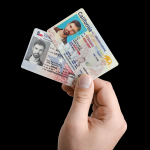Understanding Real ID: Current Standards and Operational Frameworks
Real ID refers to a set of government-mandated requirements for state-issued identification cards and driver’s licenses in the United States. Enacted under the 2005 Real ID Act, these credentials adhere to specific security protocols, including standardized data storage, tamper-resistant materials, and enhanced document validation processes. For instance, physical features like laser-engraved images, microprinting, and machine-readable zones (MRZs) are integrated to deter counterfeiting.
These IDs serve as primary forms of identification for federal purposes, such as accessing secure federal facilities or boarding domestic flights. However, their functionality remains rooted in static data structures. Information like name, date of birth, and photo is stored in fixed formats, making them susceptible to advanced forgery techniques. For example, sophisticated scanners can replicate MRZ data, while high-resolution printers can mimic microprinting, creating credible fakes that bypass basic checks.
Limitations of Traditional ID Systems: Gaps in Modern Security Demands
Traditional ID systems, including Real ID, face three critical challenges in today’s digital landscape:
1. **Static Data Vulnerability**: The fixed nature of stored information (e.g., a 2D photo) fails to account for changes in appearance over time or intentional alterations. A driver’s license issued at age 20 may not accurately represent the same individual at 40, leading to verification errors.
2. **Physical Tampering Risks**: Even with anti-tamper materials, physical IDs can be stolen, altered, or replicated. For instance, a stolen Real ID can be used to access restricted areas if the thief’s appearance closely matches the stored photo.
3. **Limited Integration with Digital Platforms**: As more services shift online, verifying a physical ID in a digital space requires manual input or scanning, which introduces delays and increases the risk of data entry errors. For example, opening a bank account remotely often requires uploading a photo of the ID, a process prone to fraud if the image is manipulated.
Holographic ID Verification: Mechanisms and Technical Breakthroughs
Holographic ID verification represents a leap forward in authentication technology. Unlike 2D images, holograms use light diffraction to create three-dimensional (3D) representations that are nearly impossible to replicate with standard printing methods. Key components of this technology include:
– **3D Imaging Capture**: Advanced cameras and lasers capture depth, texture, and surface details of the ID holder, creating a holographic “signature” unique to each individual.
– **Dynamic Holographic Layers**: Holograms often include multiple layers that shift or change when viewed from different angles or under varying light conditions. This dynamic quality makes forgery attempts immediately detectable.
– **Embedded Digital Encryption**: Holographic IDs can integrate microchips or QR codes linked to encrypted databases. Scanning the hologram triggers a real-time check against stored biometric data (e.g., fingerprints or iris patterns), ensuring the physical ID matches its digital counterpart.
For example, a holographic driver’s license might display a 3D portrait that appears to “move” when tilted, with hidden patterns visible only under UV light. These features work in tandem with a microchip storing encrypted biometric data, which is verified via a reader at checkpoints.
Comparative Analysis: Real ID vs. Holographic Verification
While Real ID sets a baseline for security, holographic verification addresses its core limitations through three key differentiators:
1. **Security Depth**: Real ID relies on physical features and static data, while holographic systems combine 3D imaging, dynamic visual elements, and digital encryption. A single holographic ID may contain over 100 unique security markers, compared to fewer than 20 in a standard Real ID.
2. **User Interaction Efficiency**: Holographic verification reduces manual checks. At airport security, for instance, a scanner can analyze the hologram and cross-reference it with biometric data in seconds, cutting wait times by up to 40% compared to manual ID checks.
3. **Scalability for Digital Services**: Holographic IDs bridge physical and digital worlds. A user can authenticate online by projecting the hologram via a smartphone camera; the system verifies both the hologram’s authenticity and the user’s real-time biometrics (e.g., a live facial scan), eliminating the need to upload static images.
Practical Applications of Holographic ID Verification
The technology’s adaptability makes it suitable for diverse sectors:
– **Transportation Security**: Airports and border checkpoints use holographic IDs to speed up passenger screening. For example, Dubai’s airports have tested holographic e-gates that verify IDs and facial features in under 5 seconds.
– **Financial Services**: Banks and fintech companies leverage holographic verification to prevent account takeover fraud. Opening a new account requires presenting a holographic ID, which is scanned to confirm both the document’s validity and the user’s identity in real time.
– **Healthcare Access**: Hospitals use holographic IDs to securely manage patient records. A patient’s holographic ID, when scanned, pulls up their medical history only after verifying their identity, reducing cases of misidentification in emergency rooms.
Common Concerns and Resolutions
As holographic ID verification gains traction, users often raise specific questions. Here are five key concerns and their solutions:
1. **”Are holographic IDs more expensive to produce than Real IDs?”**
*Solution*: While initial production costs for holographic IDs are higher (due to specialized materials and 3D imaging equipment), long-term savings emerge from reduced fraud. A 2023 study by the International Association for Identity Management found that organizations using holographic systems saw a 65% drop in ID-related fraud losses within two years, offsetting initial expenses.
2. **”Can holographic IDs be damaged easily?”**
*Solution*: Holographic materials are designed for durability. Most use polycarbonate substrates coated with scratch-resistant films, tested to withstand 5,000+ bending cycles and temperatures ranging from -40°C to 85°C. Additionally, digital backups of holographic data ensure that even a damaged physical ID can be verified via linked biometrics.
3. **”Do holographic systems work in low-light conditions?”**
*Solution*: Advanced scanners use multi-spectral sensors that capture holographic details under various lighting. For example, some systems emit controlled light wavelengths (e.g., infrared) to illuminate the hologram, making verification reliable in dim environments or at night.
4. **”How does holographic verification protect user privacy?”**
*Solution*: Holographic systems prioritize data minimization. Only essential biometric data (e.g., a facial recognition template, not the full image) is stored, and it is encrypted using AES-256 standards. Access to this data is restricted to authorized personnel, with user consent required for most verification processes.
5. **”Will holographic IDs replace Real IDs entirely?”**
*Solution*: Transition plans typically involve coexistence. Governments and organizations are likely to phase in holographic IDs while maintaining Real IDs as a fallback during the adaptation period. Over time, holographic systems may become the primary standard, but legacy systems will remain operational to ensure inclusivity for users without immediate access to new technology.


